engine coolant CADILLAC ESCALADE ESV 2008 Owner's Manual
[x] Cancel search | Manufacturer: CADILLAC, Model Year: 2008, Model line: ESCALADE ESV, Model: CADILLAC ESCALADE ESV 2008Pages: 500, PDF Size: 6.65 MB
Page 363 of 500
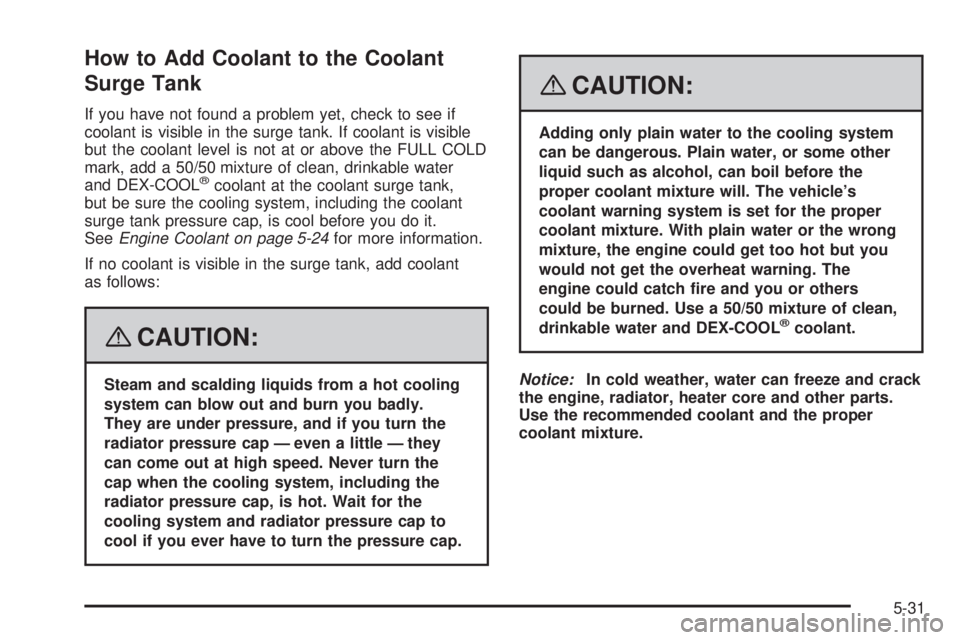
How to Add Coolant to the Coolant
Surge Tank If you have not found a problem yet, check to see if
coolant is visible in the surge tank. If coolant is visible
but the coolant level is not at or above the FULL COLD
mark, add a 50/50 mixture of clean, drinkable water
and DEX-COOL ®
coolant at the coolant surge tank,
but be sure the cooling system, including the coolant
surge tank pressure cap, is cool before you do it.
See Engine Coolant on page 5-24 for more information.
If no coolant is visible in the surge tank, add coolant
as follows:
{ CAUTION: Steam and scalding liquids from a hot cooling
system can blow out and burn you badly.
They are under pressure, and if you turn the
radiator pressure cap — even a little — they
can come out at high speed. Never turn the
cap when the cooling system, including the
radiator pressure cap, is hot. Wait for the
cooling system and radiator pressure cap to
cool if you ever have to turn the pressure cap. { CAUTION: Adding only plain water to the cooling system
can be dangerous. Plain water, or some other
liquid such as alcohol, can boil before the
proper coolant mixture will. The vehicle’s
coolant warning system is set for the proper
coolant mixture. With plain water or the wrong
mixture, the engine could get too hot but you
would not get the overheat warning. The
engine could catch �re and you or others
could be burned. Use a 50/50 mixture of clean,
drinkable water and DEX-COOL ®
coolant.
Notice: In cold weather, water can freeze and crack
the engine, radiator, heater core and other parts.
Use the recommended coolant and the proper
coolant mixture.
5-31
Page 364 of 500
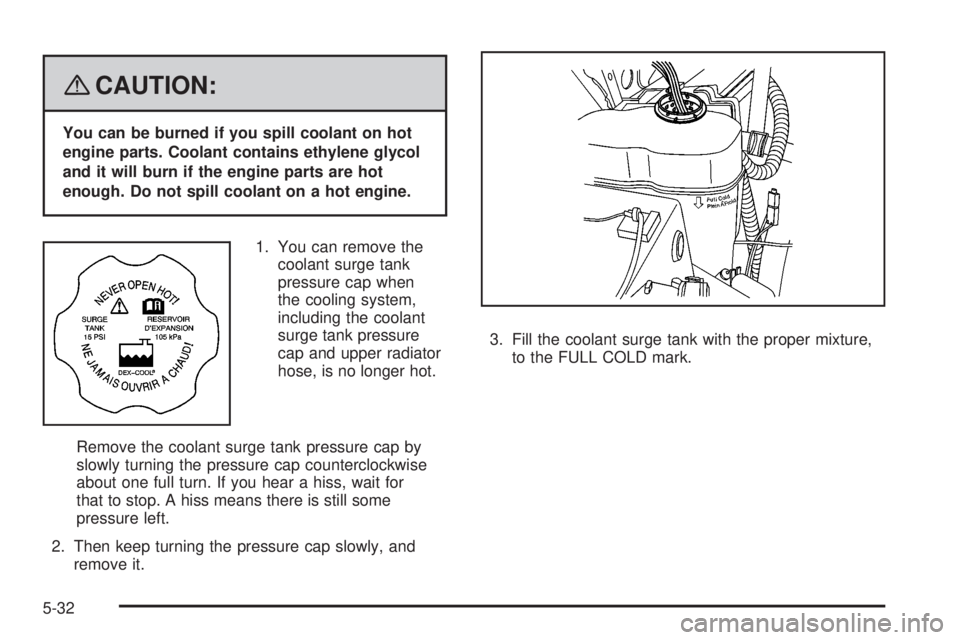
{ CAUTION: You can be burned if you spill coolant on hot
engine parts. Coolant contains ethylene glycol
and it will burn if the engine parts are hot
enough. Do not spill coolant on a hot engine.
1. You can remove the
coolant surge tank
pressure cap when
the cooling system,
including the coolant
surge tank pressure
cap and upper radiator
hose, is no longer hot.
Remove the coolant surge tank pressure cap by
slowly turning the pressure cap counterclockwise
about one full turn. If you hear a hiss, wait for
that to stop. A hiss means there is still some
pressure left.
2. Then keep turning the pressure cap slowly, and
remove it. 3. Fill the coolant surge tank with the proper mixture,
to the FULL COLD mark.
5-32
Page 365 of 500
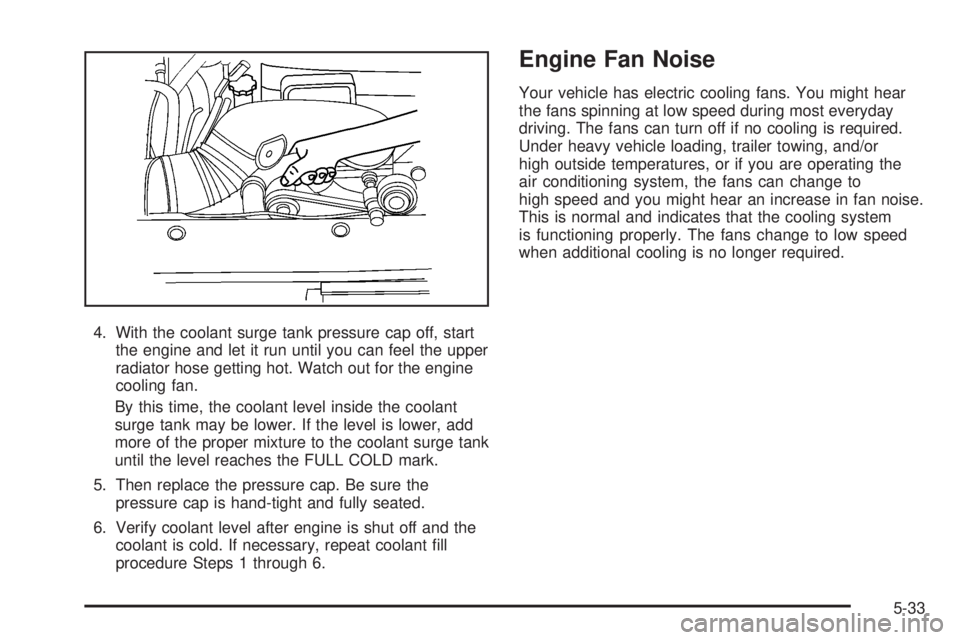
4. With the coolant surge tank pressure cap off, start
the engine and let it run until you can feel the upper
radiator hose getting hot. Watch out for the engine
cooling fan.
By this time, the coolant level inside the coolant
surge tank may be lower. If the level is lower, add
more of the proper mixture to the coolant surge tank
until the level reaches the FULL COLD mark.
5. Then replace the pressure cap. Be sure the
pressure cap is hand-tight and fully seated.
6. Verify coolant level after engine is shut off and the
coolant is cold. If necessary, repeat coolant �ll
procedure Steps 1 through 6. Engine Fan Noise Your vehicle has electric cooling fans. You might hear
the fans spinning at low speed during most everyday
driving. The fans can turn off if no cooling is required.
Under heavy vehicle loading, trailer towing, and/or
high outside temperatures, or if you are operating the
air conditioning system, the fans can change to
high speed and you might hear an increase in fan noise.
This is normal and indicates that the cooling system
is functioning properly. The fans change to low speed
when additional cooling is no longer required.
5-33
Page 367 of 500
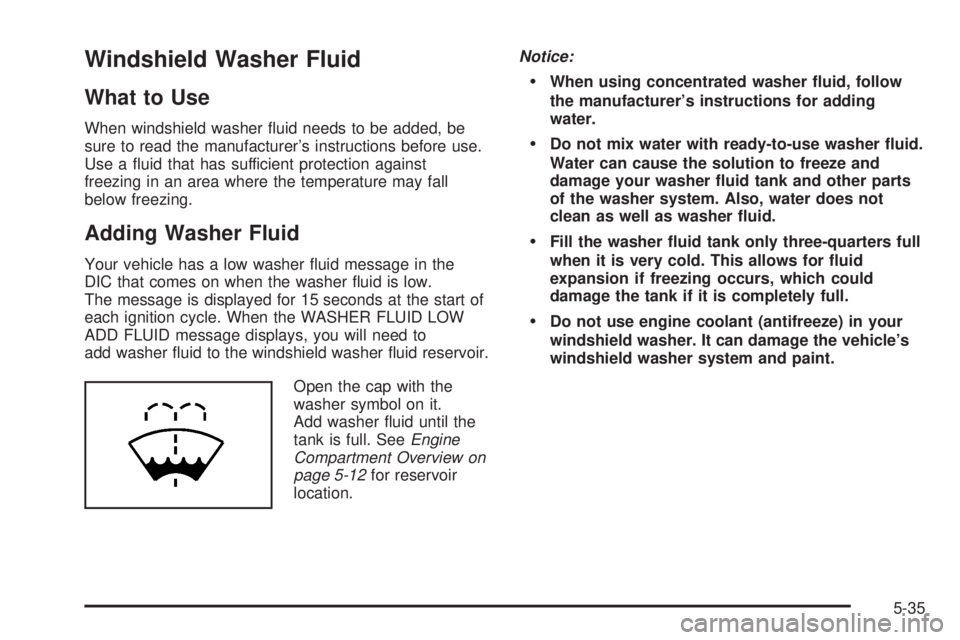
Windshield Washer Fluid What to Use When windshield washer �uid needs to be added, be
sure to read the manufacturer’s instructions before use.
Use a �uid that has sufficient protection against
freezing in an area where the temperature may fall
below freezing.
Adding Washer Fluid Your vehicle has a low washer �uid message in the
DIC that comes on when the washer �uid is low.
The message is displayed for 15 seconds at the start of
each ignition cycle. When the WASHER FLUID LOW
ADD FLUID message displays, you will need to
add washer �uid to the windshield washer �uid reservoir.
Open the cap with the
washer symbol on it.
Add washer �uid until the
tank is full. See Engine
Compartment Overview on
page 5-12 for reservoir
location. Notice:
When using concentrated washer �uid, follow
the manufacturer’s instructions for adding
water.
Do not mix water with ready-to-use washer �uid.
Water can cause the solution to freeze and
damage your washer �uid tank and other parts
of the washer system. Also, water does not
clean as well as washer �uid.
Fill the washer �uid tank only three-quarters full
when it is very cold. This allows for �uid
expansion if freezing occurs, which could
damage the tank if it is completely full.
Do not use engine coolant (antifreeze) in your
windshield washer. It can damage the vehicle’s
windshield washer system and paint.
5-35
Page 447 of 500
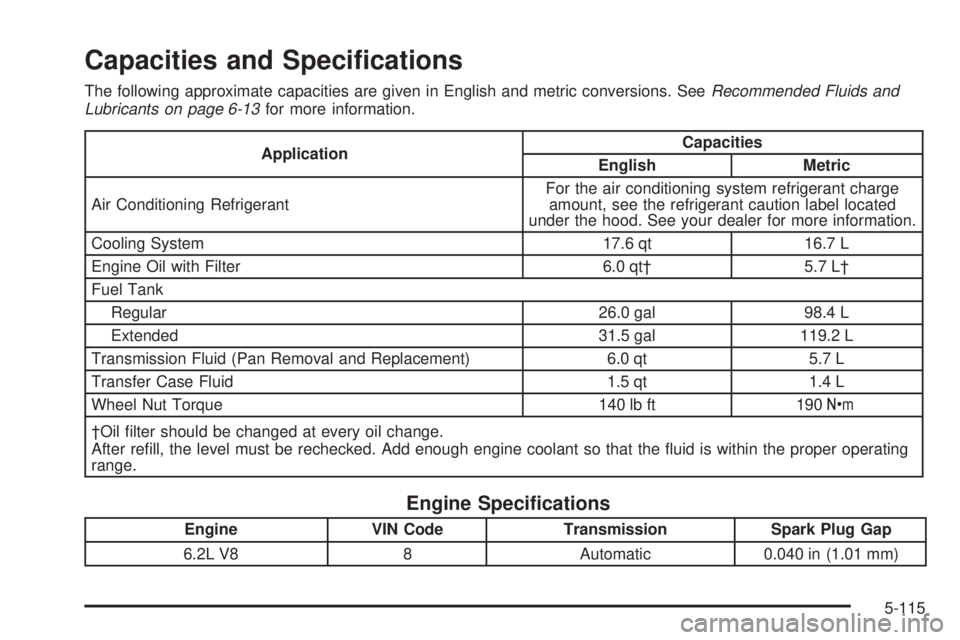
Capacities and Speci�cations The following approximate capacities are given in English and metric conversions. See Recommended Fluids and
Lubricants on page 6-13 for more information.
Application Capacities
English Metric
Air Conditioning Refrigerant For the air conditioning system refrigerant charge
amount, see the refrigerant caution label located
under the hood. See your dealer for more information.
Cooling System 17.6 qt 16.7 L
Engine Oil with Filter 6.0 qt† 5.7 L†
Fuel Tank
Regular 26.0 gal 98.4 L
Extended 31.5 gal 119.2 L
Transmission Fluid (Pan Removal and Replacement) 6.0 qt 5.7 L
Transfer Case Fluid 1.5 qt 1.4 L
Wheel Nut Torque 140 lb ft 190 Y
†Oil �lter should be changed at every oil change.
After re�ll, the level must be rechecked. Add enough engine coolant so that the �uid is within the proper operating
range.
Engine Speci�cations
Engine VIN Code Transmission Spark Plug Gap
6.2L V8 8 Automatic 0.040 in (1.01 mm)
5-115
Page 453 of 500

When the CHANGE ENGINE OIL SOON message
appears, the following services, checks, and inspections
are required:
❑ Change engine oil and �lter. See Engine Oil on
page 5-14 . Reset oil life system. See Engine Oil Life
System on page 5-16 . An Emission Control Service.
❑ Lubricate chassis components. See footnote #.
❑ Visually check for any leaks or damage. See
footnote (j).
❑ Inspect engine air cleaner �lter or change indicator (if
equipped). If necessary, replace �lter. See Engine Air
Cleaner/Filter on page 5-17 . See footnote (k).
❑ Rotate tires and check in�ation pressures and wear.
See Tire Inspection and Rotation on page 5-69 and
“Tire Wear Inspection” in At Least Once a Month
on page 6-10 . ❑ Inspect brake system. See footnote (a).
❑ Check engine coolant and windshield washer �uid
levels and add �uid as needed.
❑ Perform any needed additional services. See
“Additional Required Services” in this section.
❑ Inspect suspension and steering components. See
footnote (b).
❑ Inspect engine cooling system. See footnote (c).
❑ Inspect wiper blades. See footnote (d).
❑ Inspect restraint system components. See
footnote (e).
❑ Lubricate body components. See footnote (f).
❑ Check transmission �uid level and add �uid
as needed.
6-5
Page 457 of 500
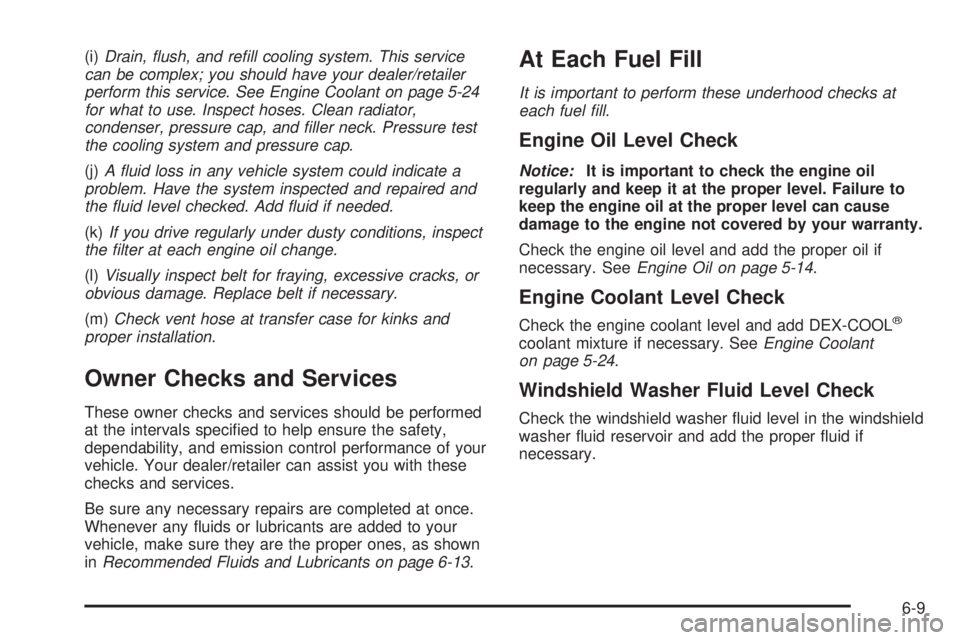
(i) Drain, flush, and refill cooling system. This service
can be complex; you should have your dealer/retailer
perform this service. See Engine Coolant on page 5-24
for what to use. Inspect hoses. Clean radiator,
condenser, pressure cap, and filler neck. Pressure test
the cooling system and pressure cap.
(j) A fluid loss in any vehicle system could indicate a
problem. Have the system inspected and repaired and
the fluid level checked. Add fluid if needed.
(k) If you drive regularly under dusty conditions, inspect
the filter at each engine oil change.
(l) Visually inspect belt for fraying, excessive cracks, or
obvious damage. Replace belt if necessary.
(m) Check vent hose at transfer case for kinks and
proper installation.
Owner Checks and Services These owner checks and services should be performed
at the intervals speci�ed to help ensure the safety,
dependability, and emission control performance of your
vehicle. Your dealer/retailer can assist you with these
checks and services.
Be sure any necessary repairs are completed at once.
Whenever any �uids or lubricants are added to your
vehicle, make sure they are the proper ones, as shown
in Recommended Fluids and Lubricants on page 6-13 .At Each Fuel Fill It is important to perform these underhood checks at
each fuel fill.
Engine Oil Level Check Notice: It is important to check the engine oil
regularly and keep it at the proper level. Failure to
keep the engine oil at the proper level can cause
damage to the engine not covered by your warranty.
Check the engine oil level and add the proper oil if
necessary. See Engine Oil on page 5-14 .
Engine Coolant Level Check Check the engine coolant level and add DEX-COOL ®
coolant mixture if necessary. See Engine Coolant
on page 5-24 .
Windshield Washer Fluid Level Check Check the windshield washer �uid level in the windshield
washer �uid reservoir and add the proper �uid if
necessary.
6-9
Page 461 of 500
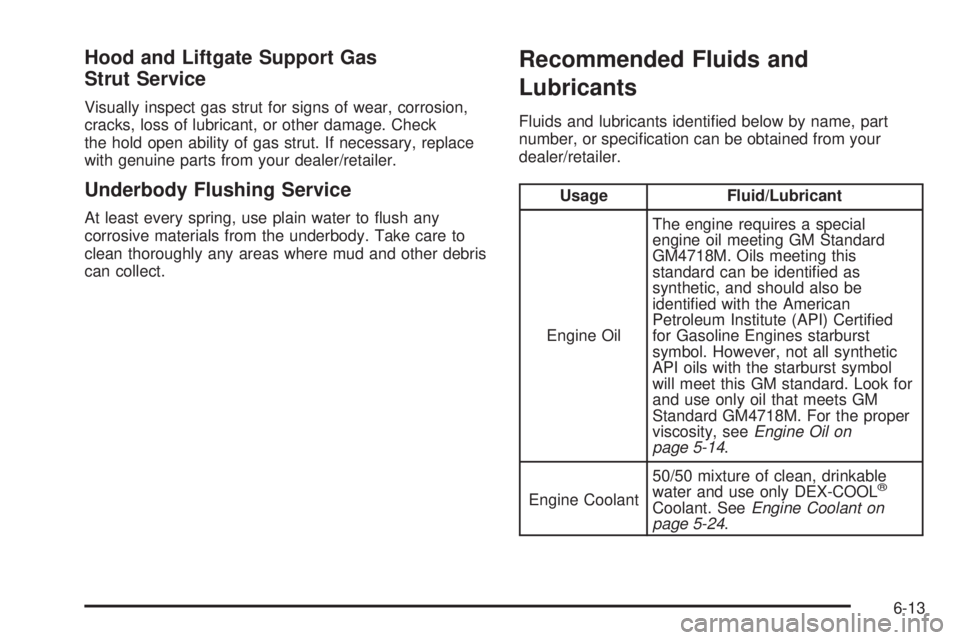
Hood and Liftgate Support Gas
Strut Service Visually inspect gas strut for signs of wear, corrosion,
cracks, loss of lubricant, or other damage. Check
the hold open ability of gas strut. If necessary, replace
with genuine parts from your dealer/retailer.
Underbody Flushing Service At least every spring, use plain water to �ush any
corrosive materials from the underbody. Take care to
clean thoroughly any areas where mud and other debris
can collect. Recommended Fluids and
Lubricants Fluids and lubricants identi�ed below by name, part
number, or speci�cation can be obtained from your
dealer/retailer.
Usage Fluid/Lubricant
Engine Oil The engine requires a special
engine oil meeting GM Standard
GM4718M. Oils meeting this
standard can be identi�ed as
synthetic, and should also be
identi�ed with the American
Petroleum Institute (API) Certi�ed
for Gasoline Engines starburst
symbol. However, not all synthetic
API oils with the starburst symbol
will meet this GM standard. Look for
and use only oil that meets GM
Standard GM4718M. For the proper
viscosity, see Engine Oil on
page 5-14 .
Engine Coolant 50/50 mixture of clean, drinkable
water and use only DEX-COOL ®
Coolant. See Engine Coolant on
page 5-24 .
6-13
Page 489 of 500

Chemical Paint Spotting ................................. 5-105
Child Restraints
Child Restraint Systems ............................... 1-57
Infants and Young Children ........................... 1-53
Lower Anchors and Tethers for Children .......... 1-61
Older Children ............................................. 1-50
Securing a Child Restraint in a Rear Seat
Position .................................................. 1-69
Securing a Child Restraint in the Center Front
Seat Position ........................................... 1-71
Securing a Child Restraint in the Right Front
Seat Position ........................................... 1-72
Where to Put the Restraint ........................... 1-60
Cigarette Lighter ............................................. 3-25
Cleaning
Aluminum or Chrome-Plated Wheels ............. 5-104
Exterior Lamps/Lenses ................................ 5-102
Fabric/Carpet ............................................ 5-100
Finish Care ............................................... 5-102
Instrument Panel, Vinyl, and Other Plastic
Surfaces ............................................... 5-101
Interior ....................................................... 5-98
Leather .................................................... 5-100
Speaker Covers ......................................... 5-101
Tires ........................................................ 5-105
Underbody Maintenance ............................. 5-105
Washing Your Vehicle ................................. 5-102
Weatherstrips ............................................ 5-101
Windshield, Backglass, and Wiper Blades ...... 5-103
Wood Panels ............................................ 5-101 Climate Control System
Dual Automatic ............................................ 3-26
Outlet Adjustment ........................................ 3-31
Rear Air Conditioning and Heating System,
Electronic ................................................ 3-31
Clock ............................................................ 3-25
Clock, Setting ................................................. 3-71
Collision Damage Repair .................................. 7-10
Compass ............................................... 2-41, 2-43
Content Theft-Deterrent .................................... 2-21
Control
of a Vehicle .......................................... 4-3
Convenience Net ............................................ 2-63
Coolant
Engine Temperature Gage ............................ 3-42
Heater, Engine ............................................ 2-28
Surge Tank Pressure Cap ............................. 5-26
Cooled Seats ................................................... 1-5
Cooling System .............................................. 5-29
Cruise Control ................................................ 3-13
Cruise Control Light ........................................ 3-47
Cupholder(s) .................................................. 2-60
Customer Assistance Information
Courtesy Transportation .................................. 7-9
Customer Assistance for Text
Telephone (TTY) Users ............................... 7-5
Customer Assistance Offices ........................... 7-5
Customer Satisfaction Procedure ..................... 7-2
GM Mobility Reimbursement Program ............... 7-6
Reporting Safety Defects to General Motors .... 7-14
3
Page 491 of 500
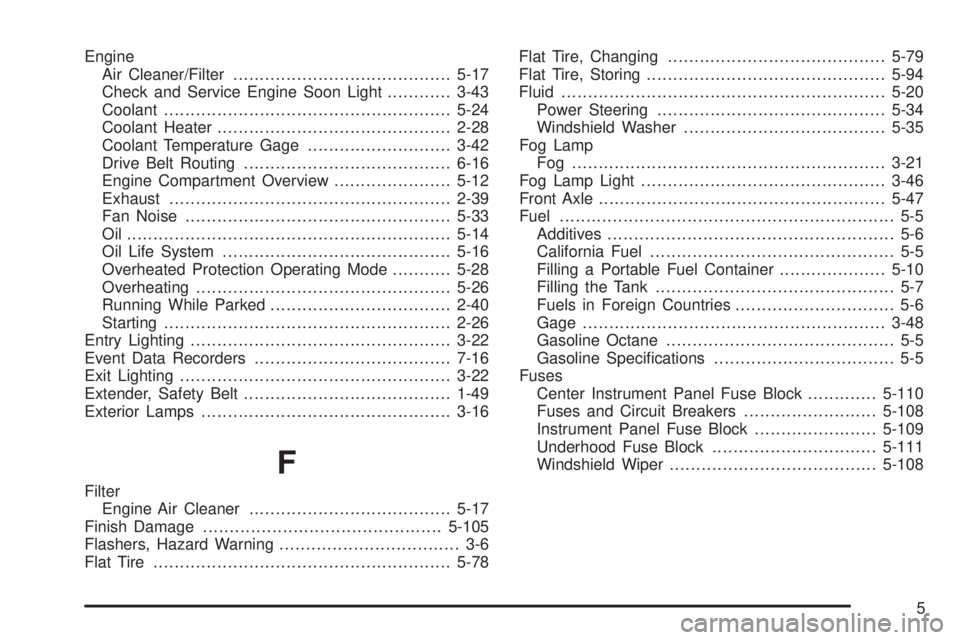
Engine
Air Cleaner/Filter ......................................... 5-17
Check and Service Engine Soon Light ............ 3-43
Coolant ...................................................... 5-24
Coolant Heater ............................................ 2-28
Coolant Temperature Gage ........................... 3-42
Drive Belt Routing ....................................... 6-16
Engine Compartment Overview ...................... 5-12
Exhaust ..................................................... 2-39
Fan Noise .................................................. 5-33
Oil ............................................................. 5-14
Oil Life System ........................................... 5-16
Overheated Protection Operating Mode ........... 5-28
Overheating ................................................ 5-26
Running While Parked .................................. 2-40
Starting ...................................................... 2-26
Entry Lighting ................................................. 3-22
Event Data Recorders ..................................... 7-16
Exit Lighting ................................................... 3-22
Extender, Safety Belt ....................................... 1-49
Exterior Lamps ............................................... 3-16
FFilter
Engine Air Cleaner ...................................... 5-17
Finish Damage ............................................. 5-105
Flashers, Hazard Warning .................................. 3-6
Flat Tire ........................................................ 5-78 Flat Tire, Changing ......................................... 5-79
Flat Tire, Storing ............................................. 5-94
Fluid ............................................................. 5-20
Power Steering ........................................... 5-34
Windshield Washer ...................................... 5-35
Fog Lamp
Fog ........................................................... 3-21
Fog Lamp Light .............................................. 3-46
Front Axle ...................................................... 5-47
Fuel ............................................................... 5-5
Additives ...................................................... 5-6
California Fuel .............................................. 5-5
Filling a Portable Fuel Container .................... 5-10
Filling the Tank ............................................. 5-7
Fuels in Foreign Countries .............................. 5-6
Gage ......................................................... 3-48
Gasoline Octane ........................................... 5-5
Gasoline Speci�cations .................................. 5-5
Fuses
Center Instrument Panel Fuse Block ............. 5-110
Fuses and Circuit Breakers ......................... 5-108
Instrument Panel Fuse Block ....................... 5-109
Underhood Fuse Block ............................... 5-111
Windshield Wiper ....................................... 5-108
5